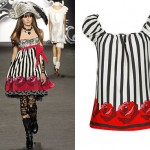 What’s in fashion???I’m already beginning to think about what I ‘ll need this Fall – I can’t help it with all the fashion mags glossily showing off the ‘new looks” for this season. But I often wonder how cheap clothes from major fashion chains impact the environment. I’ve recently returned from England where the the high street fashion turnover is insane. Jeans that were “in” last year are so “out” this year, that women wouldn’t be seen dead in them. There are a growing number of discount fashion chains where you can pick up this year’s must-have shirt or dress for under five pounds (8 bucks.) Runway knock-off’s hit the high street in minutes after the model has strutted her stuff. Things aren’t much different over here -and believe me I love a cheap tank or t-shirt! We all know that organic cotton is better for the environment, but it comes with a hefty price tag and in this economy, most of us will reach for the cheaper item and deal with the environment later.
What’s in fashion???I’m already beginning to think about what I ‘ll need this Fall – I can’t help it with all the fashion mags glossily showing off the ‘new looks” for this season. But I often wonder how cheap clothes from major fashion chains impact the environment. I’ve recently returned from England where the the high street fashion turnover is insane. Jeans that were “in” last year are so “out” this year, that women wouldn’t be seen dead in them. There are a growing number of discount fashion chains where you can pick up this year’s must-have shirt or dress for under five pounds (8 bucks.) Runway knock-off’s hit the high street in minutes after the model has strutted her stuff. Things aren’t much different over here -and believe me I love a cheap tank or t-shirt! We all know that organic cotton is better for the environment, but it comes with a hefty price tag and in this economy, most of us will reach for the cheaper item and deal with the environment later.
Aside from the awful issue of sweatshop labor – YES – those cheap clothes come with a hefty price tag, which is paid by workers who are less fortunate than us, there are even more alarming issues regarding the manufacture of the cheap clothes we love. A Greenpeace investigation has found traces of the toxin NPE in clothes made by 14 major brands. The investigation has discovered the toxic chemical nonylphenol ethoxylate (NPE) in clothing made by 14 major brands, including Adidas, H&M, Converse and Abercrombie and Fitch.
NPE breaks down to form nonylphenol in water, which disrupts hormone levels and has been known to cause fish to change gender. Due to its persistence, nonylphenol builds up in each level in the food chain, meaning humans receive the highest dosage and can suffer from hormone imbalances as a result of eating contaminated fish and water.
The chemical is banned from use in textile production in the EU but in China and other Asian countries such as Vietnam, where many global clothing brands source their products from, lax restrictions mean that NPE is widely used in the dyeing process.
Some of the clothing labels named in Greenpeace’s study have hit back, with many disputing the significance of the findings. H&M have claimed that because the methods used for testing NPE levels are uncertain, studies such as Greenpeace’s that rely on a low threshold of contamination are ‘untrustworthy’. ‘Since the level of the findings stated [by Greenpeace] are very low, you cannot show that our products contain nonylphenol ethoxylate,’ the company said in a statement to the Ecologist.
Greenpeace have dismissed these objections as ‘nonsense’. ‘For Greenpeace the concentration levels don’t matter at all,’ explained Marietta Harjono, Greenpeace International Toxic Campaigner. ‘The levels that we have found are not an indication of toxic discharges that have occurred during production,’ she added, implying that lower levels in the finished clothing items could simply mean that more of the chemical had been washed into the water supply earlier in the process.
Harjono believes that the problem will not be solved until clothing brands pay more attention to their supply chain. ‘What we really want from a company like Adidas is to respect the right to know. We are seeking transparency throughout the supply chain and we want them to force their suppliers to disclose their chemical discharges.’
Thank goodness for large organizations like Greenpeace, who monitor these serious threats to our precious ecosystem and pressure the offending companies to change their ways.
There are many other issues regarding how the manufacture of our clothes can negatively impact the environment. An example is “Killer Jeans” – called this because of the terrible health consequences of sandblasting the jeans to get that look. If you are interested, visit Labour Behind The Label to see more of what might be going on behind some of your favorite brands.
So before you hit the high street for a bit of retail therapy – remember, it might well be trendy and the hottest Fall fashion, but it also might be harming other people and the planet. If in doubt, I often send an email to the company asking for transparency. Sometimes I’m pleasantly surprised by a swift and thorough reply – sometimes not!


Sophie,
That’s great to point out what’s bad out there, but we need an alternative. I’m doing what I can; recycling, reusing, composting, & trying to live as green as possible. However, as a single young woman, I want to be fabulous & green. I need to know what’s out there that is eco-friendly & sexy & fashionable, or else I’m stuck buying what’s bad for the earth, because I have no choice. (And trust me, I have been looking.)
Pretty! This was a really wonderful article.
Many thanks for supplying this information.